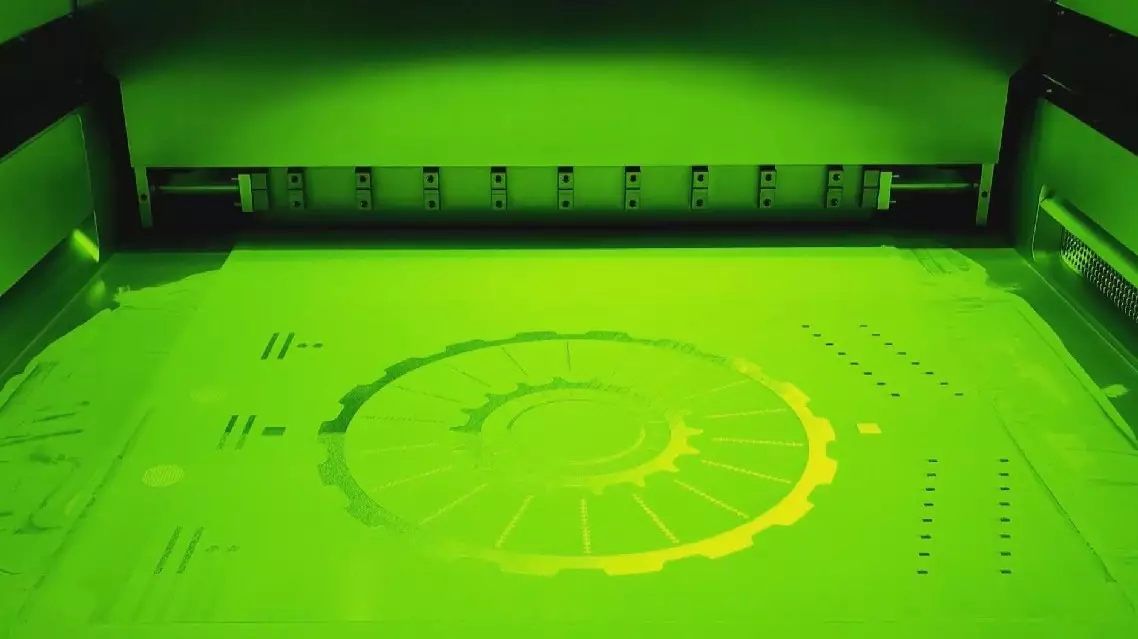Researchers at a laboratory in Foshan City, south China’s Guangdong Province, have deepened their research on metal 3D printing technology, also known as metal additive manufacturing, to upgrade the traditional materials manufacturing industry.
Metal 3D printing is a laser-based technology that constructs objects layer by layer by fusing metal particles. It employs heat or light energy, such as a laser or electron beam, to melt or bond the metal powder, spreading it over previous layers.
According to a researcher at the Institute of Advanced Additive Manufacturing of Ji Hua Laboratory, 3D printing has a great advantage in fabricating arbitrary shapes without any limitations and has great potential in preparing controllable porous structures.
“In traditional methods of processing, we need to produce these channels first and then weld them at the corresponding points, which can result in tiny welding defect pores in the welding area. However, 3D printing completely avoids the possibility of welding defects because it is integrally formed. Our whole industry is gradually developing in the direction of larger sizes, more lasers, and higher efficiency,” said Gao Chaofeng, doctoral student at the Institute of Advanced Additive Manufacturing of Ji Hua Laboratory.
Another researcher at the lab pointed out that they aim to make more progress in new material and key components development in some key areas.
“We aim to solve some of the main difficulties in the industry at present, such as improving the quality and performance of products and reducing costs. In the long run, we strive to develop new materials and future technologies in China, especially in equipment such as key components for engines and aerospace fields,” said Bi Yunjie, deputy director of the Institute of Advanced Additive Manufacturing of Ji Hua Laboratory.
Ji Hua Laboratory is one of the first four provincial-level laboratories initiated by the Guangdong Provincial Party Committee and the Provincial Government. Since its establishment more than six years ago, the laboratory has mainly focused on new display equipment, semiconductor equipment and key components, intelligent robots, high-end medical equipment, advanced remote sensing equipment, additive manufacturing equipment, and new materials and devices.
Chinese scientists leverage metal 3D printing to upgrade traditional material manufacturing industry
Tourist attractions across China have seen a surge of international and domestic visitors during the peak summer season.
The Beijing Central Axis has become a popular destination for tourists from home and abroad since it was recently listed as a UNESCO World Heritage site. Tourist trips around the Axis average 2.26 million daily with 3,700 tour groups organized, after the local tourism authorities created thematic routes for tourists to explore historical and cultural spots along the way.
As this year marks the 50th anniversary of the archaeological discovery of the Terracotta Warriors of the Qin Dynasty (221 B.C.-207 B.C.), the Emperor Qinshihuang’s Mausoleum Site Museum in Xi’an in northwest China’s Shaanxi Province has received more than 1.8 million visitor trips during this summer peak. Cooling equipment has been installed at the ticket gate of the museum to make the visits more comfortable.
Dunhuang City in northwest China’s Gansu Province, renowned for the Mogao Caves, has seen more than double the number of tourists this year than last. Authorities at the Mogao Caves have initiated emergency measures to ensure smooth and orderly visits.
The Shandong Museum in Jinan City in east China’s Shandong Province is exhibiting over 1,000 cultural relics, including oracle bone inscriptions from the Shang Dynasty (1600-1046 B.C.), attracting 400,000 visitor trips in July.
The ancient canal in Wuxi City in east China’s Jiangsu Province, and the lively street performers in the area, attracted over 4 million tourist trips in July. The city has become a popular destination for students and family tours.
“The culture and landscape are appealing, so I brought my child here to experience during the summer vacation,” said Huang, a tourist.
Xishuangbanna, in southwest China’s Yunnan Province, renowned for its unique flora and fauna, has held scientific activities geared to tourists at the Tropical Botanical Garden, which is run by the Chinese Academy of Sciences.
The cool weather in Liupanshui City, in southwest China’s Guizhou Province, has become a haven for sports and outdoor enthusiasts from around the world, while Chongqing Municipality in southwest China and Gao’an City in east China’s Jiangxi Province have laid on water sports and other activities for visitors.
The Beiji (Arctic) Village in Mohe, northeast China’s Heilongjiang Province, is another popular summer resort for tourists offering an average temperature of a cool 18 degrees Celsius in summer.
“It’s vast and the air is fresh. I’ve got to learn a lot of new plants and animals here,” said Guo Xiaomu, a tourist.
Tourist attractions across China embrace surge in visitor numbers



